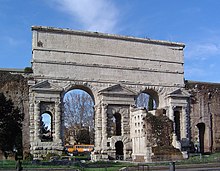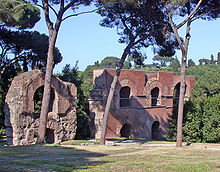Frontinus
Sextus Julius Frontinus | |
|---|---|
| Born | c. 40 AD |
| Died | 103 (aged 62–63) AD |
| Nationality | Roman |
| Occupation(s) | Engineer, author, soldier & politician |
| Notable work | De aquaeductu Strategemata |
| Office | Roman consul |
| Children | 1+ |
Sextus Julius Frontinus (c. 40 – 103 AD) was a prominent Roman civil engineer, author, soldier and senator of the late 1st century AD. He was a successful general under Domitian, commanding forces in Roman Britain, and on the Rhine and Danube frontiers. A novus homo, he was consul three times. Frontinus ably discharged several important administrative duties for Nerva and Trajan. However, he is best known to the post-Classical world as an author of technical treatises, especially De aquaeductu, dealing with the aqueducts of Rome.
Family[edit]
Due to a lack of either a titulus honorarius or sepulcralis, there is no outline of Frontinus' life, the names of his parents, or of his wife. Some details can be inferred from chance mentions: He is thought to be of Narbonese origins, and originally of the equestrian class.[1] From the nomenclature of the name of Publius Calvisius Ruso Julius Frontinus (consul c. 84), it is likely Frontinus had a sister, who was the other's mother.[2] Frontinus had at least one daughter, the wife of Quintus Sosius Senecio (cos. 99, II 107) and mother of Sosia Polla.[3]
Career[edit]
In AD 70, Frontinus participated in the suppression of the Rhineland revolt, and later recorded that he received the surrender of 70,000 Lingones.[4] Between that date and being appointed governor of Britain to succeed Quintus Petillius Cerialis a few years later, Frontinus was appointed suffect consul. While governor of Britain, he subjugated the Silures of South Wales and is thought to have likewise campaigned against the Brigantes.[5] He was succeeded by Gnaeus Julius Agricola, the father-in-law of the famous historian Tacitus, in 77. Birley believes it "is fair to speculate" that Frontinus was with Domitian during the German campaign of 83. An inscription at Hieropolis in Phrygia, as well as a number of coins of Smyrna, attests that he was proconsul of Asia in AD 86.[5]
In 97, he was appointed curator aquarum (supervisor of the aqueducts) by the emperor Nerva, an office only conferred upon persons of very high standing. In this capacity, he followed another distinguished Roman statesman, Agrippa, the friend, ally and son-in-law of Augustus, who organised in 34 BC a campaign of public repairs and improvements, including renovation of the aqueduct Aqua Marcia and an extension of its pipes to cover more of the city.
The following year Frontinus held a second consulship as suffect in February, with Trajan as his colleague, and two years later he was made consul ordinarius with Trajan. Birley notes, "This exceptional honour underlines the high regard in which he [Frontinus] was held, and suggests, further, that Trajan had a debt to repay."[6] He was also a member of the College of Augurs.[6] He died in 103 or 104, a date based on Pliny the Younger writing to his friends that he was elected to the college of augurs to fill the vacancy Frontinus' death had created.[6]
Writings[edit]
Aqueducts of Rome[edit]

Frontinus's chief work is De aquaeductu, in two books, an official report to the emperor on the state of the aqueducts of Rome. It presents a history and description of the water-supply of Rome, including the laws relating to its use and maintenance. He provides the history, sizes and discharge rates of all of the nine aqueducts of Rome at the time at which he was writing at the turn of the 1st century AD: the Aqua Marcia, Aqua Appia, Aqua Alsietina, Aqua Tepula, Anio Vetus, Anio Novus, Aqua Virgo, Aqua Claudia and Aqua Augusta. Frontinus describes the quality of water delivered by each, mainly depending on their source, be it river, lake, or spring.
Fraud and theft[edit]
One of the first jobs he undertook when he was appointed water commissioner was to prepare maps of the system so that he could assess their condition before undertaking their maintenance. He says that many had been neglected and were not working at their full capacity. He was especially concerned by diversion of the supply by unscrupulous farmers and tradesmen, among many others. They would insert pipes into the channel of the aqueducts to tap the supply. He, therefore, made a meticulous survey of the intake and the supply of each line, and then investigated the discrepancies. Lead pipe stamps bearing the name of the owner were also used to prevent such water theft. He was well aware of the seminal work De architectura by Vitruvius, which mentions aqueduct construction and maintenance published in the previous century; Frontinus refers to the possible influence of Vitruvius on the plumbers.[7]

Distribution system[edit]
Distribution of the water depended in a complex way on its height entering the city, the quality of the water, and its rate of discharge. Thus, poor-quality water would be sent for irrigation, gardens, or flushing, while only the best would be reserved for drinking water. Intermediate-quality water would be used for the many baths and fountains. However, Frontinus criticized the practice of mixing supplies from different sources, and one of his first decisions was to separate the waters from each system.
Maintenance[edit]
He was very concerned by leaks in the system, especially those in the underground conduits, which were difficult to locate and mend, a problem still faced by water engineers today. The aqueducts above ground needed care to ensure that the masonry was kept in good condition, especially those running on arched superstructures. It was, he said, essential to keep trees at a distance so that their roots would not damage the structures. He reviewed the existing law governing the state aqueducts, as well as the need for enforcement of those statutes.
Military tactics[edit]
Frontinus also wrote a theoretical treatise on military science, which is lost. His extant work on military matters, the Stratagems (Latin: Strategemata), is a collection of examples of military stratagems from Greek and Roman history, for the use of generals. He draws on his own experience as a general in Germania under Domitian, but similarities between the anecdotes he records and versions of other Roman authors like Valerius Maximus and Livy suggest that he drew mainly on literary sources. The authenticity of the fourth book has been challenged.[8] One example he gives of control of river water during a siege reads:
Lucius Metellus, when fighting in Hither Spain, diverted the course of a river and directed it from a higher level against the camp of the enemy, which was located on low ground. Then, when the enemy were in a panic from the sudden flood, he had them slain by men whom he had stationed in ambush for this very purpose.
Selected editions and translations[edit]

De aquaeductu[edit]
- The standard edition of the Latin text of Frontinus' major work, with extensive commentary in English, is now R.H. Rodgers, Frontinus: De aquaeductu urbis Romae (Cambridge University Press, 2004).
- Rodgers has published his English translation online [1]
- An English translation by Charles E. Bennet, edited by Mary B. McElwain, has been published in the Loeb Classical Library.[9]
- A translation by Herschel is useful for his commentary on the engineering aspects of the De aquaeductu.
Other works[edit]
- The latest edition of the Stratagems is by R. I. Ireland (Teubner, 1990 ISBN 3-322-00746-4) (in Latin); English translation in Loeb Classical Library (translated by Charles Bennet and edited by Mary B. McElwain), 1925. ISBN 9780674991927
- Extracts from a treatise on land surveying ascribed to Frontinus are preserved in B. Campbell (2000), The Writings of the Roman Land Surveyors: Introduction, Text, Translation and Commentary, London.
- The Stratagems and The Aqueducts of Rome , translated by Charles E. BENNETT (1858 - 1921), available on Librivox as an audiobook.
In fiction[edit]
He appears as a fictionalised character in the Marcus Didius Falco novels The Silver Pigs, Shadows in Bronze, Three Hands in the Fountain, and The Jupiter Myth. He also appears as a character in The Centurions novels Barbarian Princess and The Emperor's Games.
See also[edit]
References[edit]
- ^ William McDermott, "Stemmata quid faciunt? The descendants of Frontinus", Ancient Society, 7 (1976), p. 255
- ^ Ronald Syme, "P. Calvisius Ruso. One Person or Two?", Zeitschrift für Papyrologie und Epigraphik, 56 (1984), pp. 190f
- ^ McDermott, "Stemmata quid faciunt?", p. 254
- ^ Strategemata 4.3.14. A.R. Birley, The Fasti of Roman Britain (Oxford: Clarendon Press, 1981), p. 70
- ^ a b Birley, Fasti, p. 71
- ^ a b c Birley, Fasti, p. 72
- ^ [25:1]
- ^ Paper by Rogier van der Wal (Amsterdam) to the 2010 Classical Association Conference, Cardiff
- ^ no. L174, Stratagems. De aquaeductu (1925)
- This article incorporates text from a publication now in the public domain: Chisholm, Hugh, ed. (1911). "Frontinus, Sextus Julius". Encyclopædia Britannica. Vol. 11 (11th ed.). Cambridge University Press. p. 250.
Further reading[edit]
- Ashby, Thomas (1934) The Aqueducts of Rome, Oxford.
- Blackman, Deane R., Hodge, A. Trevor (2001). Frontinus' Legacy: Essays on Frontinus' de aquis urbis Romae. University of Michigan Press. ISBN 978-0-472-06793-0
- Dahm, Murray K (1997), The Career and Writings of Sextus Julius Frontinus. Master's Thesis, University of Auckland.
- Herschel, C (1973) The Two Books on The Water Supply of the City of Rome of Frontinus, (trans with explanatory chapters) New England Water Works Association.
- Hodge, A.T. (2001). Roman Aqueducts & Water Supply, 2nd ed. London: Duckworth.
External links[edit]
- Frontinus at LacusCurtius: full texts of De aquis and Strategemata in Latin and English; illustrated with some of the Monscassinensis manuscript from the Herschel edition.
- Works by Sextus Julius Frontinus at Project Gutenberg
- Works by or about Frontinus at Internet Archive
- Works by Frontinus at LibriVox (public domain audiobooks)

- Sextus Iulius Frontinus (fr)
- Models of Various Aqueducts of Ancient Rome
- Routes of Various Aqueducts of Ancient Rome
- Famous Fountains of Rome
- The Fountains of Rome (by Region)
- Spanish site dedicated to Roman technology, especially aqueducts and mines
- 40s births
- 103 deaths
- 1st-century Romans
- 1st-century writers
- 2nd-century Romans
- Ancient Romans in Britain
- Ancient Roman civil engineers
- Augurs of the Roman Empire
- Julii
- Imperial Roman consuls
- Roman aqueducts
- Roman governors of Britain
- Roman governors of Asia
- Ancient Roman military writers
- Silver Age Latin writers
